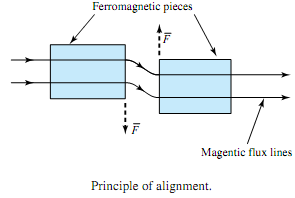Q. Illustrate the principle of alignment?
Pieces of highly permeablematerial, such as iron, situated in ambientmediumof lowpermeability, such as air, in which a magnetic field is established, experience mechanical forces that tend to align them with the field direction in such a way that the reluctance of the system is minimized (or the inductance of the system is maximized). Figure illustrates this principle of alignment and shows the direction of forces. The force is always in a direction that reduces the net magnetic reluctance and shortens the magnetic flux path.
A mechanical force is exerted on ferromagnetic material, tending to align it with or bring it into the position of the densest part of the magnetic field. This force is the familiar attraction of a magnet for pieces of iron in its field. In magnetic circuits, for example, definite forces are exerted on the iron at the air-iron boundary. Energy changes associated with a differential displacement of the iron cause themechanical force. This force is the essential operatingmechanismofmany electromagnetic devices, such as liftingmagnets,magnetic clutches, chucks, brakes, switches (known as contactors), and relays. Solenoid-operated (solenoid being another name for the operating coil) valves are common elements in piping systems. Actuators used in control systems operate due to the mechanical force or torque converted from the electric, pneumatic, or hydraulic inputs.

In motor and generator action, the magnetic fields tend to line up, pole to pole. When their complete alignment is prevented by the need to furnish torque to a mechanical shaft load, motor action results when electric tomechanical energy conversion takes place. On the other hand, when the alignment is prevented by the application of a mechanical torque to the rotor from a source of mechanical energy, generator action results when mechanical to electric energy conversion takes place.